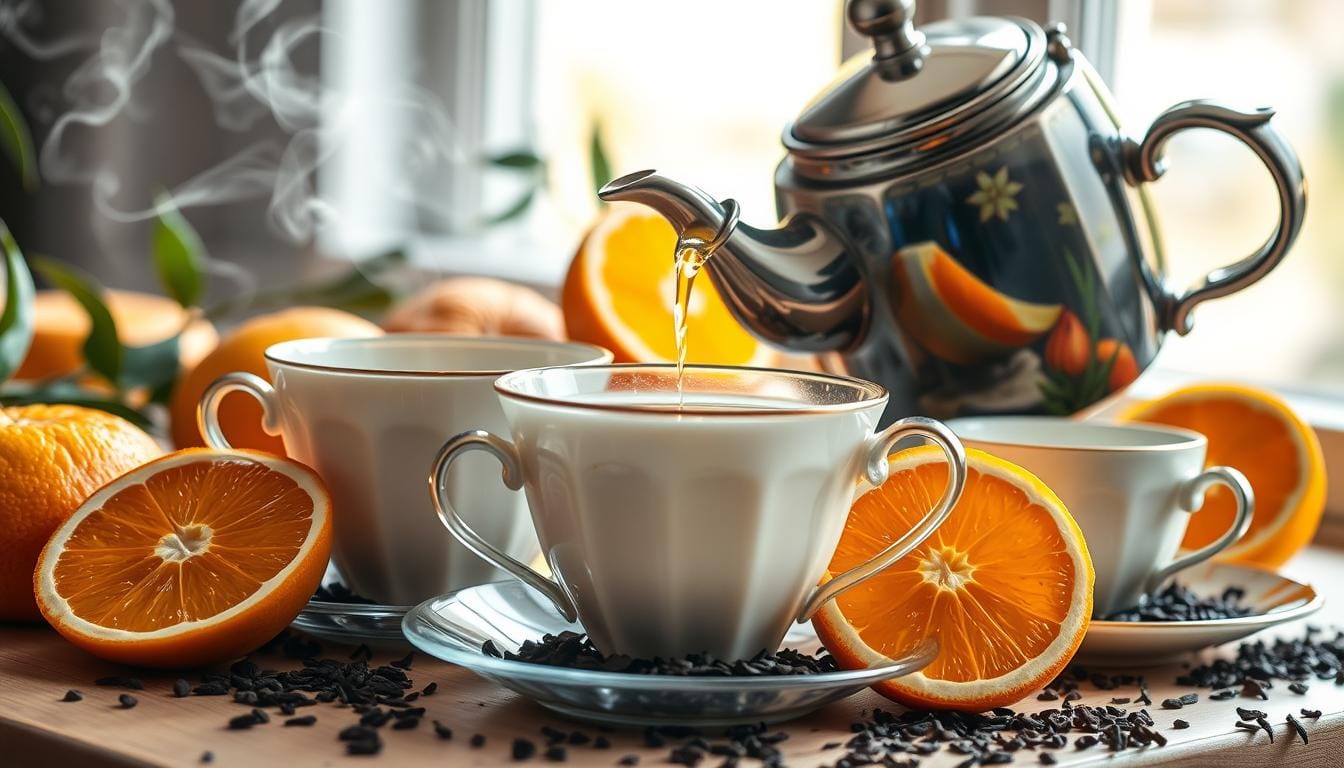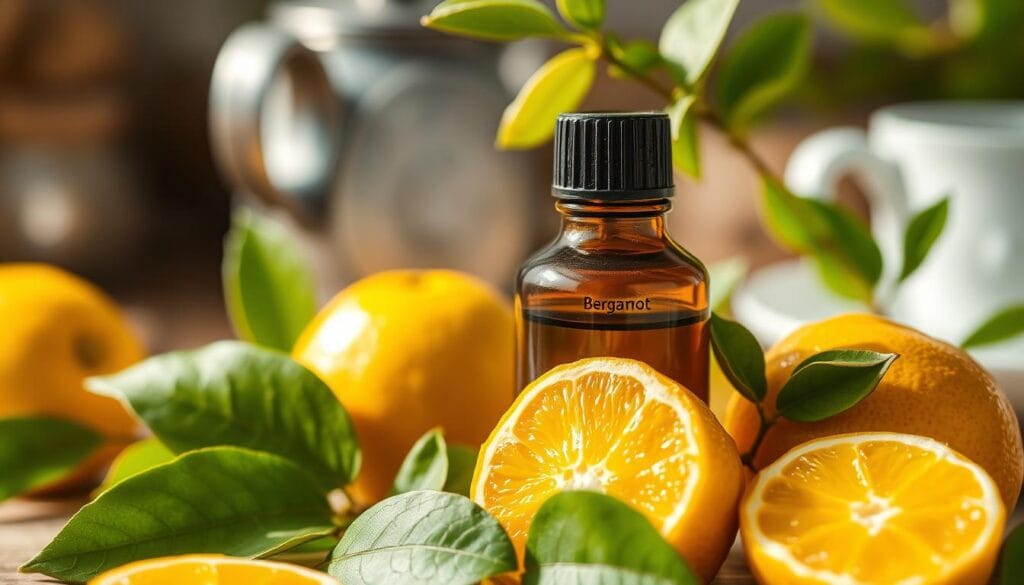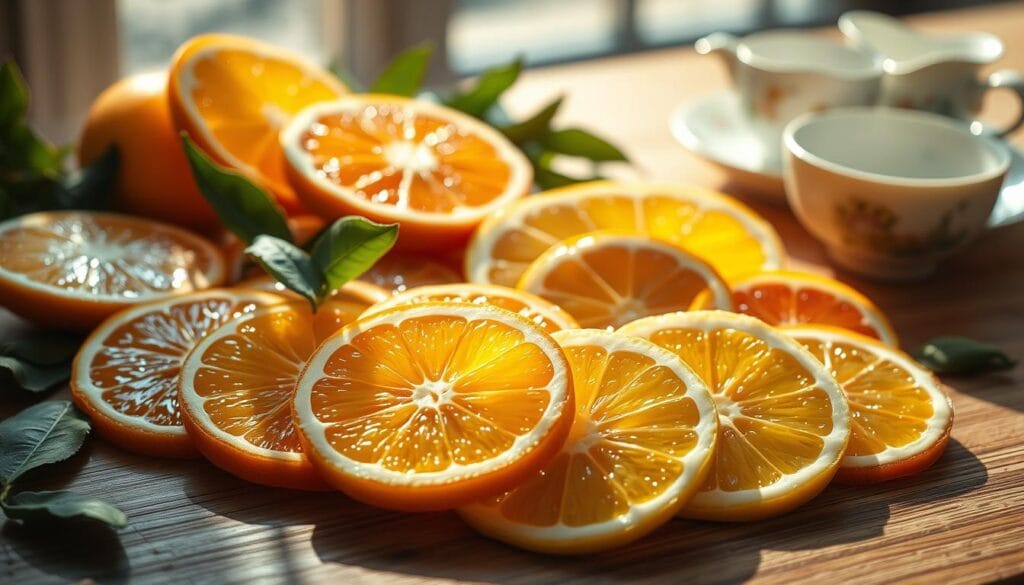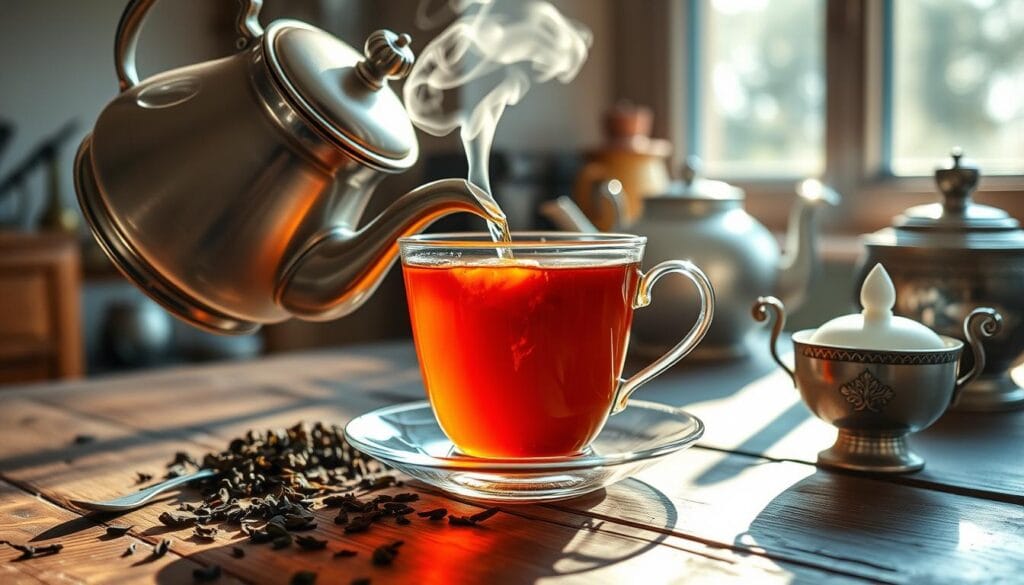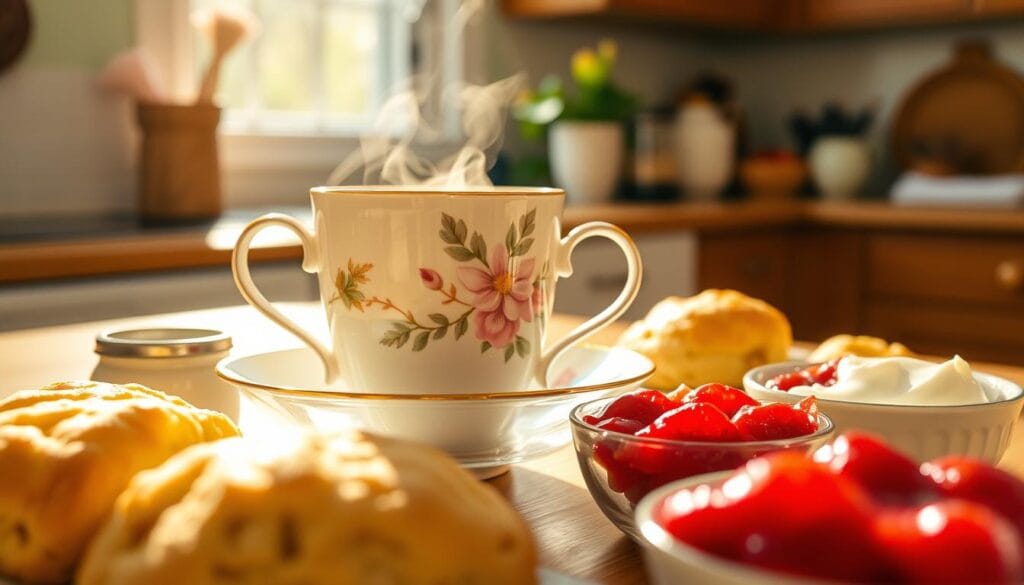I’ve always loved the unique tastes and rich stories of different teas. Earl Grey and English Breakfast are two of the most famous black teas. Each has its own special flavor and fans. Knowing the differences between Earl Grey and English Breakfast can make your tea time even better.
Earl Grey and English Breakfast are both classic black teas from the UK. But they have different tastes and ingredients. This makes them special in their own ways. Let’s explore these teas together and discover what makes them unique.
Introduction to Earl Grey and English Breakfast Tea
Earl Grey and English Breakfast teas are two favorites in the tea world. They come from the Camellia sinensis plant but have different origins and tastes. Each tea is special and loved by many.
What Defines Earl Grey?
Earl Grey tea is known for its bergamot flavor. This comes from bergamot oranges’ essential oil. It adds a citrusy, floral taste with hints of spice, malt, and smoke.
The bergamot oil is mixed with high-quality black tea leaves. This makes a tea that is both sophisticated and aromatic.
What Defines English Breakfast Tea?
English Breakfast tea is bold and has a malty flavor. It’s a mix of black teas like Ceylon, Assam, and Tanzanian. This blend makes a strong and full-bodied tea.
This tea is great for starting your day. It has a robust and invigorating taste.
Even though both teas come from the Camellia sinensis plant, they are made differently. This results in their unique tastes and cultural meanings.
The History Behind Earl Grey Tea
Earl Grey tea has a rich history that started in the 19th century. It’s named after Charles Grey, a British Prime Minister from the early 1800s. But, where it came from is still a mystery to many tea lovers.
Origin of the Name
One legend says Jacksons of Piccadilly made Earl Grey for the Second Earl Grey. They used bergamot oil to make the tea taste better. This was because the Earl’s family home had soft water.
Historical Evolution
Earl Grey tea has changed over time. Now, you can find green, oolong, and herbal versions. The tea history and bergamot flavor are key to its fame. Today, it’s loved by tea fans everywhere.
“Earl Grey tea was first mentioned in 1824 and has since become one of the most popular tea flavors globally.”
Even though its origins are unclear, Earl Grey’s fame is undeniable. Whether you like the traditional black tea or a modern twist, its bergamot flavor shows its lasting charm and tea history.
The History Behind English Breakfast Tea
English Breakfast tea is a favorite in British culture for centuries. Its exact start is unclear, but it’s tied to the UK’s tea traditions.
Its British Roots
The first English Breakfast tea mix was noted in 1843. It combines the best black teas from India, Sri Lanka, Kenya, Malawi, and China. This strong tea was made to go well with the English breakfast, a key meal in British homes.
Richard Davies, an English immigrant, started a tea company in New York City in 1843. He marketed his blend as “English Breakfast.” But, similar teas were around since the 17th and 18th centuries, thanks to tea traders.
Cultural Significance
English Breakfast tea became very popular during Queen Victoria’s time. Its strong taste and match with English breakfasts made it a favorite in many homes.
Today, English Breakfast tea is a top choice worldwide, with the UK leading. You can find it in cafes, restaurants, and homes, showing its lasting cultural importance.
| Tea Blend | Key Characteristics |
|---|---|
| English Breakfast | Robust, full-bodied, and designed to complement hearty English breakfasts |
| Irish Breakfast | Has a higher proportion of Assam leaves, resulting in a darker, more astringent taste |
| Scottish Breakfast | Known for its particularly woodsy flavor with almost a smoky edge |
In summary, English Breakfast tea’s history is closely linked to the UK’s tea traditions. It shows the country’s rich culture and love for this tea.
Key Ingredients in Earl Grey Tea
Earl Grey tea is famous for its citrusy taste, thanks to bergamot essential oil. This oil comes from the bergamot orange, grown mainly in the Mediterranean. It’s what makes Earl Grey unique among black tea blends.
The Role of Bergamot
Bergamot oil gives Earl Grey its unique smell and taste. It has a spicy and floral scent. This is mixed with black tea leaves to make the classic Earl Grey flavor.
The bergamot’s bright, slightly bitter taste goes well with the black tea’s strong and malty flavor. This mix creates a refreshing and balanced tea.
Other Common Ingredients
- Black tea: Earl Grey is usually made with black tea, but some use green, oolong, or herbal tea instead.
- Lavender: Some blends add lavender for a more complex flavor.
- Cornflowers: Blue cornflowers are used to make the tea look and smell better.
The mix of bergamot oil, black tea, and sometimes lavender or cornflowers makes Earl Grey special. It’s a favorite tea globally for its unique and sophisticated taste.
Key Ingredients in English Breakfast Tea
English Breakfast tea is a classic mix of black teas. It offers a strong, full-bodied taste. The blend includes black teas from famous tea-growing areas.
Blend of Black Teas
English Breakfast tea is a mix of black teas from India, Sri Lanka, and Africa. The exact mix can change, but it aims for a balanced flavor. This results in a tea that’s bold and full.
- Assam black tea: Contributes a rich, malty character to the blend.
- Ceylon black tea: Offers a bright, slightly astringent quality.
- Kenyan black tea: Adds a spicy, robust note to the mixture.
Flavor Components
The mix of black teas in English Breakfast tea is carefully made. It has a unique flavor. The tea often has:
- Malty notes, from the Assam black tea.
- Slightly spicy and astringent undertones, from Kenyan and Ceylon black teas.
- A full-bodied, robust taste for a satisfying drink.
The mix of these teas, with the skill of tea blenders, makes English Breakfast tea flavorful and refreshing.
| Key Ingredient | Origin | Flavor Contribution |
|---|---|---|
| Assam Black Tea | India | Malty, robust |
| Ceylon Black Tea | Sri Lanka | Bright, slightly astringent |
| Kenyan Black Tea | Kenya | Spicy, hearty |
“The key to a perfect English Breakfast tea lies in the balance of its black tea components, each contributing its unique flavor profile to create a harmonious and invigorating brew.”
Flavor Profiles of Earl Grey Tea
Earl Grey tea is famous for its citrus taste, thanks to bergamot oil. It has a balanced flavor with citrus, spice, malt, and a smoky hint. The aroma is floral and refreshing, making it a favorite among tea lovers.
Citrus Notes
The bergamot essential oil, from the bergamot orange rind, is key to Earl Grey’s citrus flavor. The bergamot’s strength can vary, offering a light or bold citrus taste. This lets tea fans choose their Earl Grey based on their taste.
Aroma and Depth
Earl Grey tea also has a complex aroma and flavor. Black tea’s malty base is enhanced by spice and smoky notes. This mix of flavors makes it a refreshing and satisfying tea, loved by many.
“Earl Grey tea is a unique and captivating blend that tantalizes the senses with its sophisticated citrus notes and aromatic complexity.”
Flavor Profiles of English Breakfast Tea
English Breakfast tea is known for its strong and malty flavor. It’s a black tea that’s full-bodied and hearty. It’s great with milk and sweeteners, making it a favorite for mornings.
The malty taste is a key feature of English Breakfast. It also has subtle spice notes and a bit of astringency.
The flavor of English Breakfast tea can change based on the tea flavors in the blend. It usually includes black teas from India, Sri Lanka, Kenya, Malawi, and China. This mix creates a bold, awakening taste perfect for starting your day.
“English Breakfast tea is the second most consumed beverage in the world after water.”
English Breakfast tea is full-bodied. The mix of black teas gives it a malty taste that’s rich and satisfying. It has a slightly drying finish, making it great for breakfast or a mid-afternoon boost.
English Breakfast tea is always satisfying, whether with milk, sugar, or on its own. Its strong character and malty undertones make it a favorite globally.
Caffeine Content: Earl Grey vs English Breakfast
Earl Grey and English Breakfast teas are favorites for many. But, they have different amounts of caffeine. Knowing how much caffeine is in each can help you pick the right tea for you.
Caffeine Levels in Earl Grey
Earl Grey tea combines black tea leaves with bergamot oil. This gives it a unique citrus taste. A cup of Earl Grey usually has 20-58 mg of caffeine. That’s less than a cup of coffee, which can have up to 95 mg.
Caffeine Levels in English Breakfast
English Breakfast tea, on the other hand, is a mix of strong black teas. It often includes Indian Assam, Chinese, and African teas. This mix means a cup of English Breakfast usually has 40-80 mg of caffeine. It’s a more energizing choice, perfect for a morning pick-me-up.
| Tea Type | Caffeine Content (per cup) |
|---|---|
| Earl Grey | 20-58 mg |
| English Breakfast | 40-80 mg |
The tea caffeine content and black tea types are key to these teas’ caffeine levels. Earl Grey offers a gentle caffeine boost. English Breakfast, however, gives a more intense tea experience for those who love a strong brew.
“The differences in caffeine content between Earl Grey and English Breakfast teas are fascinating. It’s important to understand these nuances to make the best choice for your personal preferences and needs.”
Brewing Techniques for Earl Grey Tea
To brew the perfect Earl Grey tea, you need to balance temperature and steeping time. Heat the water to about 200°F (93°C). This temperature brings out the tea’s flavors without making it bitter.
Steeping time varies from 3 to 5 minutes, based on your taste. Steeping too long can make the tea bitter. Adjust the time if you like it stronger or weaker.
Earl Grey tea is great both hot and iced. It’s also perfect for making a London Fog latte. For green or oolong Earl Grey blends, you might need to tweak the temperature and steeping time a bit.
“The key to brewing a perfect cup of Earl Grey is finding the sweet spot between water temperature and steeping time. With a little practice, you’ll be able to unlock the tea’s full aromatic and flavorful potential.”
Brewing Techniques for English Breakfast Tea
Getting the perfect cup of English Breakfast tea is all about the right techniques. This black tea blend is famous for its strong, full-bodied taste. It’s a favorite for both morning and afternoon tea.
Ideal Brewing Methods
To get the best out of English Breakfast tea, use near-boiling water at 205°F (96°C). This temperature helps the tea leaves infuse well, bringing out all the flavors. For a balanced taste, steep the tea for 3 to 5 minutes. Steeping it longer will make the flavor stronger.
Steeping Recommendations
- Use 2-4 grams of tea leaves per cup of water for optimal strength.
- Steep the tea for 3-5 minutes to achieve the desired intensity.
- For a stronger brew, increase the amount of tea leaves rather than extending the steeping time to avoid bitterness.
- English Breakfast tea is traditionally served with the addition of milk and sugar, allowing you to customize the flavor to your personal preference.
By following these brewing techniques, you can unlock the full potential of English Breakfast tea. Enjoy its bold, malty taste in every sip.
Popular Pairings with Earl Grey Tea
Earl Grey tea is known for its unique bergamot flavor. It goes well with many foods and moments. Enjoying this tea can make your tea time even better and introduce you to tasty flavor mixes.
Food Pairings
Earl Grey’s citrus taste is great with desserts and pastries. Try it with lemon tarts, chocolate-infused treats, and croissants. It also pairs well with savory foods like smoked salmon and delicate sandwiches.
- Citrus-flavored desserts
- Chocolate-based confections
- Light pastries and baked goods
- Smoked salmon and seafood dishes
- Delicate sandwiches and finger foods
Ideal Time for Consumption
Earl Grey tea is perfect for any time of day. It’s refreshing, making it great for afternoon tea or as a palate-cleansing drink after eating. In summer, it’s a cool refreshing iced tea choice, offering a bright and cheerful option.
| Tea Pairing | Recommended Pairings |
|---|---|
| Earl Grey |
|
Exploring tea pairings and food combinations with Earl Grey can enhance your tea experience. It opens up new ways to enjoy this favorite drink.
Popular Pairings with English Breakfast Tea
English Breakfast tea is great with many breakfast foods and snacks. Its strong taste is perfect for big morning meals.
Food Combinations
Enjoy English Breakfast tea with eggs, bacon, sausages, toast, and pastries. Its malty taste goes well with these foods. It also pairs well with savory sandwiches, scones, and snacks.
Perfect Occasions for Enjoyment
English Breakfast tea is great for breakfast pairings and is perfect for cold months. Its strong taste is great for starting the day, a mid-afternoon boost, or a cozy nightcap.
| Tea Variety | Caffeine Content | Flavor Profile |
|---|---|---|
| Earl Grey | 40-70 mg per cup | Citrusy bergamot notes |
| English Breakfast | 50-80 mg per cup | Robust, malty, and full-bodied |
English Breakfast tea has more caffeine and a stronger taste than Earl Grey. It’s a favorite for breakfast pairings and tea occasions all day.
“English Breakfast tea is a staple in many households, known for its ability to complement hearty morning meals and provide a comforting pick-me-up any time of day.”
Conclusion: Which Tea Should You Choose?
Choosing between Earl Grey and English Breakfast tea depends on your taste and how you plan to use it. Earl Grey has a unique, citrusy taste that many find appealing. It’s great for those who like a lighter, more aromatic tea.
English Breakfast, on the other hand, has a strong, full-bodied taste. It’s perfect for those who want a traditional black tea that’s robust.
Assessing Your Preferences
Consider what you like in a tea and when you’ll drink it. If you prefer a delicate, floral tea, Earl Grey might be for you. It’s calming and aromatic.
But if you like a bold, malty tea to wake you up, English Breakfast is the way to go. It’s strong and energizing.
Final Thoughts on Both Teas
Both Earl Grey and English Breakfast teas are great in different settings. They’re perfect for formal teas or just enjoying at home. The choice between them depends on your taste and how you see tea in your life.
Try both to see which one you like best. It’s all about finding the tea that suits your taste and lifestyle.
FAQ
What is the difference between Earl Grey and English Breakfast tea?
Earl Grey and English Breakfast are both black teas from England. The main difference is in their ingredients. English Breakfast is just black tea leaves. Earl Grey adds bergamot essential oil to black tea.
This change affects their taste and characteristics.
What defines Earl Grey tea?
Earl Grey tea is known for its bergamot flavor. This comes from bergamot oranges. It tastes smooth, with citrus, spice, malt, and smoke notes.
What defines English Breakfast tea?
English Breakfast tea is bold and malty. It’s made from a mix of Ceylon, Assam, and Tanzanian black teas.
What is the origin of the name “Earl Grey” tea?
Earl Grey tea is named after Charles Grey, a 19th-century British Prime Minister. Its creation story is debated. One tale says it was made by Jacksons of Piccadilly for Lord Grey.
What is the history behind English Breakfast tea?
English Breakfast tea was created by Robert Drysdale in 1892. Yet, similar teas existed 60 years before. It became popular during Queen Victoria’s reign and is now a British favorite.
What is the key ingredient in Earl Grey tea?
Bergamot essential oil is the key in Earl Grey tea. It comes from bergamot oranges grown in the Mediterranean. This oil gives Earl Grey its unique citrusy flavor.
What is the typical blend in English Breakfast tea?
English Breakfast tea blends black teas from India, Sri Lanka, and Africa. This mix includes Assam, Ceylon, and teas from Kenya or Tanzania.
How would you describe the flavor profile of Earl Grey tea?
Earl Grey tea has a distinct citrusy taste. It’s balanced, with citrus, spice, malt, and a hint of smoke.
How would you describe the flavor profile of English Breakfast tea?
English Breakfast tea is robust and full-bodied. It has a strong malty taste with spice notes and moderate astringency.
What is the caffeine content in Earl Grey and English Breakfast teas?
Both teas have caffeine, being black tea-based. English Breakfast has more caffeine due to its strong tea blend.
How do you brew Earl Grey tea properly?
Brew Earl Grey with water at 200°F (93°C). Steep for 3-5 minutes for the right strength. Avoid over-steeping to prevent bitterness.
How do you brew English Breakfast tea properly?
Brew English Breakfast with water at 205°F (96°C). Steep for 3-5 minutes for a balanced taste. Longer steeping makes it stronger.
What foods pair well with Earl Grey tea?
Earl Grey goes well with citrus desserts, chocolate, and light pastries. Its bergamot notes complement these flavors. It’s great in the afternoon or as a dessert tea.
What foods pair well with English Breakfast tea?
English Breakfast tea pairs well with hearty breakfasts like eggs, bacon, toast, and pastries. Its strong flavor holds up to milk and sugar.
Which tea should you choose between Earl Grey and English Breakfast?
Choose Earl Grey for its unique citrus flavor or English Breakfast for a robust taste. Your choice depends on your taste and how you plan to use the tea.

